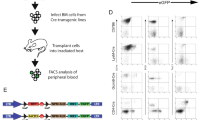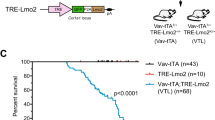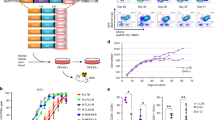Abstract
Proviral insertions at the viral insertion site Lvis1 occur frequently in B- and T-cell leukemias and lymphomas in AKXD mice and activate two nearby genes, the divergent homeobox gene Hex and the kinesin-related spindle protein gene Eg5. To determine whether Hex misexpression results in the altered differentiation or neoplastic transformation of hematopoietic lineages, we have transplanted mice with bone marrow cells transduced with retrovirus containing the Hex coding region. High levels of Hex expression in hematopoietic precursor cells inhibit contribution to mature blood cell lineages by these precursors. Hex bone marrow transplant recipient mice also develop hematologic neoplasms that appear to originate in the bone marrow. The tumors have clonal rearrangements of the TCR locus, are Thy1+, and are CD4+CD8+, CD4−CD8−, or mixed, indicating tumor origin from a precursor T-cell population. Tumors in transplant mice contain clonal and transcriptionally active Hex proviral insertions, demonstrating a causal role for Hex misexpression in the onset of these neoplasms. Our results demonstrate that Hex can act as a T lineage oncogene when misexpressed in hematopoietic precursor cells.
This is a preview of subscription content, access via your institution
Access options
Subscribe to this journal
Receive 50 print issues and online access
$259.00 per year
only $5.18 per issue
Buy this article
- Purchase on Springer Link
- Instant access to full article PDF
Prices may be subject to local taxes which are calculated during checkout






Similar content being viewed by others
References
Aster J, Xu L, Karnell F, Patriub V, Pui J and Pear W . (2000). Mol. Cell. Biol., 20, 7505–7515.
Bedford F, Ashworth A, Enver T and Wiedemann L . (1993). Nucleic Acids Res., 21, 1245–1249.
Behrens A, Sabapathy K, Graef I, Cleary M, Crabtree GR and Wagner EF . (2001). Proc. Natl. Acad. Sci. USA, 98, 1769–1774.
Bogue CW, Ganea GR, Sturm E, Ianucci R and Jacobs HC . (2000). Dev. Dyn., 19, 84–89.
Bogue CW, Zhang PX, McGrath J, Jacobs HC and Fuleihan RL . (2003). Proc. Natl. Acad. Sci. USA, 100, 556–561.
Crompton M, Bartlett T, MacGregor A, Manfioletti G, Buratti E, Giancotti V and Goodwin G . (1992). Nucleic Acids Res., 20, 5661–5667.
Goldfarb AN and Greenberg JM . (1994). Leuk. Lymphoma, 12, 157–166.
Hansen G and Justice MJ . (1999). Oncogene, 18, 6531–6539.
Hawley RG, Fong AZ, Reis MD, Zhang N, Lu M and Hawley TS . (1997). Cancer Res., 57, 337–345.
Hawley RG, Lieu FH, Fong AZ and Hawley TS . (1994). Gene Ther., 1, 136–138.
Ho CY, Houart C, Wilson SW and Stainier DY . (1999). Curr. Biol., 19, 1131–1134.
Hough MR, Reis MD, Singaraja R, Bryce DM, Kamel-Reid S, Dardick I, Breitman ML and Dube ID . (1998). Proc. Natl. Acad. Sci. USA, 95, 13853–13858.
Hromas R, Radich J and Collins S . (1993). Biochem. Biophys. Res. Commun., 195, 976–983.
Jayaraman PS, Frampton J and Goodwin G . (2000). Leuk. Res., 24, 1023–1031.
Jonkers J and Berns A . (1996). Biochim. Biophys. Acta, 1287, 29–57.
Keng VW, Yagi H, Ikawa M, Nagano T, Myint Z, Yamada K, Tanaka T, Sato A, Muramatsu I, Okabe M, Sato M and Noguchi T . (2000). Biochem. Biophys. Res. Commun., 276, 1155–1161.
Krosl J and Sauvageau G . (2000). Oncogene, 19, 5134–5141.
Liao W, Ho CY, Yan YL, Postlethwait J and Stainier DY . (2000). Development, 127, 4303–4313.
Look A . (1997). Science, 278, 1059–1064.
Mack DL, Liebowitz, DS, Cooper S, Ramsey H, Broxmeyer HE and Hromas R . (2002). Immunology, 107, 444–451.
Manfioletti G, Gattei V, Buratti E, Rustighi A, De IA, Aldinucci D, Goodwin G and Pinto A . (1995). Blood, 85, 1237–1245.
Martinez Barbera JP, Clements M, Thomas P, Rodriguez T, Meloy D, Kioussis D and Beddington RS . (2000). Development, 127, 2433–2445.
Morse HC 3rd, Anver MR, Fredrickson TN, Haines DC, Harris AW, Harris NL, Jaffe ES, Kogan SC, MacLennan IC, Pattengale PK, Ward JM and Hematopathology subcommittee of the Mouse Models of Human Cancers Consortium. (2002). Blood, 100, 246–258.
Mucenski ML, Taylor BA, Jenkins NA and Copeland NG . (1986). Mol. Cell. Biol., 6, 4236–4243.
Nakagawa T, Abe M, Yamazaki T, Miyashita H, Niwa H, Kokubun S and Sato Y . (2003). Arterioscler. Thromb. Vasc. Biol., 23, 231–237.
Newman CS, Chia F and Krieg PA . (1997). Mech. Dev., 66, 83–93.
Owens B and Hawley R . (2002). Stem Cells, 20, 364–379.
Persons DA, Allay JA, Allay ER, Ashmun RA, Orlic D, Jane SM, Cunningham JM and Nienhuis AW . (1999). Blood, 93, 488–499.
Porcher C, Swat W, Rockwell K, Fujiwara Y, Alt FW and Orkin SH . (1996). Cell, 86, 47–57.
Rosenberg N . (1994). Semin. Cancer Biol., 5, 95–102.
Sawyers CL and Witte ON . (2001). The Molecular Basis of Blood Diseases, 3rd edn. Stamatoyannopoulos G, Majerus PW, Perlmutter RM and Varmus H (eds.), WB Saunders Company: Philadelphia.
Schaefer LK, Wang S and Schaefer TS . (2001). J. Biol. Chem., 276, 43074–43082.
Shalaby F, Ho J, Stanford WL, Fischer KD, Schuh AC, Schwartz L, Bernstein A and Rossant J . (1997). Cell, 89, 981–990.
Suzuki T, Shen H, Akagi K, Morse III HC, Malley JD, Naiman DQ, Jenkins NA and Copeland NG . (2002). Nat. Genet., 32, 166–174.
Tanaka T, Inazu T, Yamada K, Myint Z, Keng VW, Inoue Y, Taniguchi N and Noguchi T . (1999). Biochem. J., 339 (Part 1), 111–117.
Thomas PQ, Brown A and Beddington RS . (1998). Development, 125, 85–94.
Thorsteinsdottir U, Sauvageau G and Humphries K . (1997). Hematol. Oncol. Clin. N. Am., 11, 1221–1237.
Acknowledgements
We thank Dr Robert Hawley for providing the MSCV-PGK-Hph construct, and Drs Warren Pear and Margaret Goodell for protocols and advice on bone marrow transduction and transplantation. We also thank Dr Clifford Bogue for providing Hex antiserum and for sharing results prior to publication. We wish to acknowledge Cammy Mason-Garrison for expert assistance with necropsies and other members of the Justice laboratory for technical assistance and valuable discussions. Finally, we thank Dr Jeffrey Rosen, Dr Sharon Plon, Dr Lawrence Donehower, Dr Margaret Goodell, and Dr John Belmont for advice and critical review of this manuscript. This work was supported by N.I.H. Public Health Service Grant CA63229 to MJJ.
Author information
Authors and Affiliations
Corresponding author
Rights and permissions
About this article
Cite this article
George, A., Morse III, H. & Justice, M. The homeobox gene Hex induces T-cell-derived lymphomas when overexpressed in hematopoietic precursor cells. Oncogene 22, 6764–6773 (2003). https://doi.org/10.1038/sj.onc.1206822
Received:
Revised:
Accepted:
Published:
Issue Date:
DOI: https://doi.org/10.1038/sj.onc.1206822
Keywords
This article is cited by
-
PML-RAR alpha induces the downmodulation of HHEX: a key event responsible for the induction of an angiogenetic response
Journal of Hematology & Oncology (2016)
-
Misregulation of the proline rich homeodomain (PRH/HHEX) protein in cancer cells and its consequences for tumour growth and invasion
Cell & Bioscience (2016)
-
Highly recurrent mutations of SGK1, DUSP2 and JUNB in nodular lymphocyte predominant Hodgkin lymphoma
Leukemia (2016)
-
Hhex regulates Kit to promote radioresistance of self-renewing thymocytes in Lmo2-transgenic mice
Leukemia (2015)
-
PRH/HHex inhibits the migration of breast and prostate epithelial cells through direct transcriptional regulation of Endoglin
Oncogene (2014)



